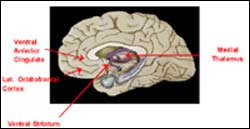Depression traced to overactive brain circuit

Areas that show over-activity following tryptophan depletion in depression patients in remission — and thought to reflect a trait dysfunction — include emotion regulating circuitry involving the anterior cingulate, thalamus, ventral striatum and orbitofrontal cortex.
A brain imaging study by the NIH’s National Institute of Mental Health (NIMH) has found that an emotion-regulating brain circuit is overactive in people prone to depression – even when they are not depressed. Researchers discovered the abnormality in brains of those whose depressions relapsed when a key brain chemical messenger was experimentally reduced. Even when in remission, most subjects with a history of mood disorder experienced a temporary recurrence of symptoms when their brains were experimentally sapped of tryptophan, the chemical precursor of serotonin, the neurotransmitter that is boosted by antidepressants.
Neither a placebo procedure in patients nor tryptophan depletion in healthy volunteers triggered the mood and brain activity changes. Brain scans revealed that a key emotion-processing circuit was overactive only in patients in remission – whether or not they had re-experienced symptoms – and not in controls. Since the abnormal activity did not reflect mood state, the finding suggests that tryptophan depletion unmasks an inborn trait associated with depression.
Alexander Neumeister, M.D., Dennis Charney, M.D., Wayne Drevets, M.D., NIMH Mood and Anxiety Disorders Program, and colleagues, report on their positron emission tomography (PET) scan study in the August 2004 Archives of General Psychiatry.
The NIMH researchers and others had previously shown that omitting tryptophan from a cocktail of several other essential amino acids washes out the precursor chemical from the blood and brain, depleting serotonin and often triggering symptoms in people with a history of depression – and even in healthy people from depression-prone families. This added to evidence that a genetic predisposition that renders some people vulnerable to inadequate serotonin activity may be at the root of the mood disorder.
The researchers scanned subjects after their blood tryptophan levels were reduced by about three-fourths, using a radioactive tracer (a form of glucose, the brain’s fuel) which reveals where the brain is active during a particular experimental condition.
They randomly gave 27 unmedicated depressed patients-in-remission and 19 controls either pills containing seven essential amino acids, such as lysine and valine, or identical-looking placebo pills. Subjects received either the active pills or placebos in repeated trials over several days in a blind, crossover design.
Sixteen (59 percent) of the patients experienced a transient return of symptoms under tryptophan depletion; their mood lifted to normal by the next day. Compared to controls, the patients showed increased brain activity in a circuit coursing through the front and center of the brain (orbitofrontal cortex, thalamus, anterior cingulate, and ventral striatum) – areas involved in regulating emotions and motivation that have been implicated in previous studies of depression. Whereas previous studies interpreted the circuit activation as a transient, mood-dependent phenomenon, the new evidence suggests that circuit over-activation is likely an underlying vulnerability trait, say the researchers.
Because of its ability to unmask what appears to be a trait marker for major depressive disorder, the researchers suggest that tryptophan depletion may be a useful tool for studying the genetic basis of depression.
“Since brain function appears to be disregulated even when patients are in remission, they need to continue long-term treatment beyond the symptomatic phase of their illness,” noted Neumeister, who recently moved to the Yale University psychiatry department.
Media Contact
More Information:
http://www.nih.govAll latest news from the category: Health and Medicine
This subject area encompasses research and studies in the field of human medicine.
Among the wide-ranging list of topics covered here are anesthesiology, anatomy, surgery, human genetics, hygiene and environmental medicine, internal medicine, neurology, pharmacology, physiology, urology and dental medicine.
Newest articles

“Nanostitches” enable lighter and tougher composite materials
In research that may lead to next-generation airplanes and spacecraft, MIT engineers used carbon nanotubes to prevent cracking in multilayered composites. To save on fuel and reduce aircraft emissions, engineers…

Trash to treasure
Researchers turn metal waste into catalyst for hydrogen. Scientists have found a way to transform metal waste into a highly efficient catalyst to make hydrogen from water, a discovery that…

Real-time detection of infectious disease viruses
… by searching for molecular fingerprinting. A research team consisting of Professor Kyoung-Duck Park and Taeyoung Moon and Huitae Joo, PhD candidates, from the Department of Physics at Pohang University…





















